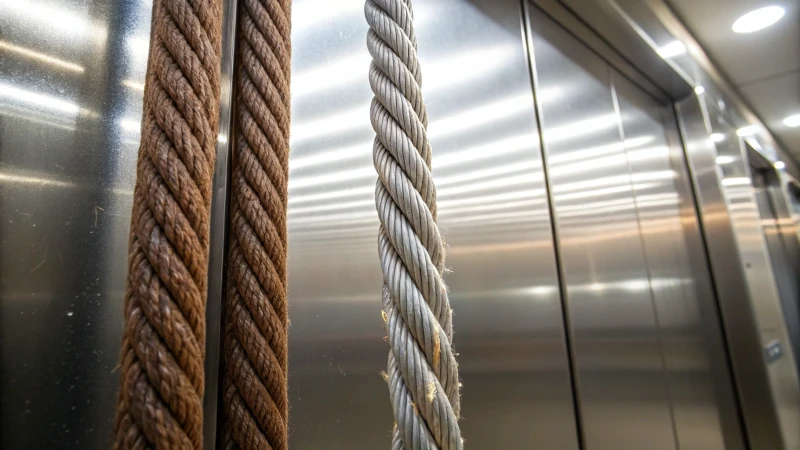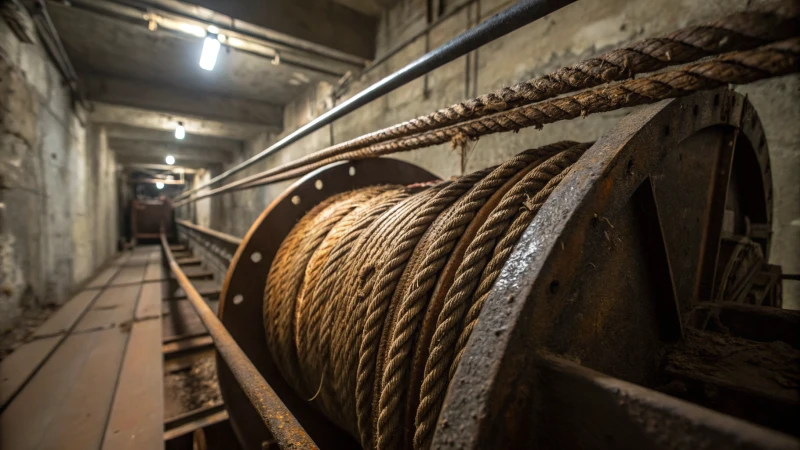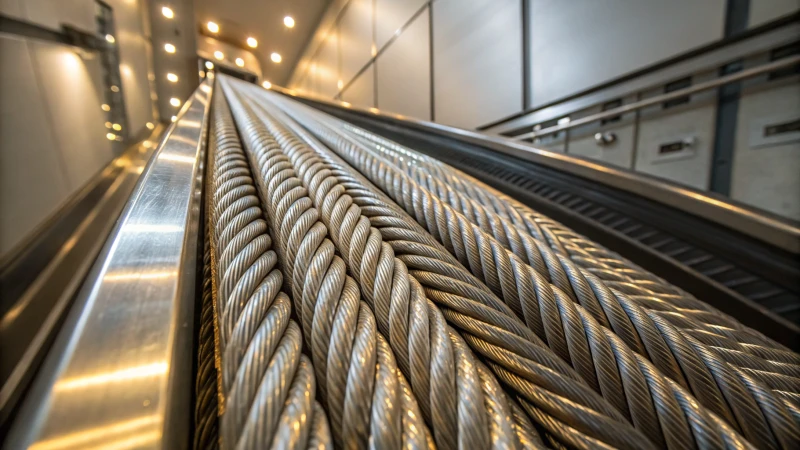
Navigating the complexities of underground elevator systems can be daunting, but choosing the right wire rope makes all the difference.
Steel wire ropes excel in underground elevators due to their remarkable strength, resistance to corrosion, and durability in harsh conditions. Stainless steel varieties stand out for their superior longevity and performance, making them a top pick for demanding subterranean environments.
I remember the first time I was tasked with selecting wire ropes for an underground project—it felt overwhelming. The stakes were high, and the wrong choice could lead to costly downtime or even safety hazards. Thankfully, diving into the world of steel wire ropes unveiled a solution. Stainless steel ropes, with their robust resilience against corrosion and environmental stressors, quickly emerged as the frontrunners. They not only promised longevity but also offered peace of mind knowing they could withstand the challenging underground conditions. It's this reliable performance that makes them an indispensable choice for anyone managing subterranean elevator operations.
Steel wire ropes are corrosion-resistant.True
Steel wire ropes resist corrosion, making them suitable for harsh environments.
Aluminum ropes are preferred over steel for elevators.False
Steel ropes are favored due to their strength and durability, unlike aluminum.
Why Choose Stainless Steel Over Galvanized Steel for Elevator Ropes?
When choosing elevator ropes, the battle between stainless steel and galvanized steel is fierce. As someone who's navigated these choices, I can share why stainless steel might just be your best bet.
Stainless steel ropes are often favored over galvanized ones for elevators due to their superior corrosion resistance and durability, which are essential for safety and longevity in high-stress environments.

Corrosion Resistance: A Critical Factor
When I first encountered the challenge of selecting the right material for elevator ropes, it was clear that the environment played a huge role. Stainless steel ropes shine in humid or corrosive settings—unlike galvanized steel, which can rust over time. I remember a project where the elevator ropes were exposed to harsh coastal conditions, and stainless steel turned out to be the hero, resisting corrosion with ease. It's truly the top choice for places like underground or coastal installations.
Stainless steel is inherently resistant to corrosion1, making it a preferred choice for elevators exposed to harsh conditions.
Durability and Longevity
Durability is always on my mind when making procurement decisions. I once had a chat with a colleague, John2, who is a procurement manager. He shared how stainless steel ropes can last up to 30% longer than their galvanized counterparts, according to ISO 4344 data. For him—and for me—this means fewer maintenance headaches and cost savings. Knowing that these ropes can reduce downtime is invaluable.
| Material | Corrosion Resistance | Service Life | Maintenance Frequency |
|---|---|---|---|
| Stainless Steel | High | Longer | Less Frequent |
| Galvanized Steel | Moderate | Shorter | More Frequent |
Environmental Impact and Cost Considerations
I often weigh the initial cost against the long-term benefits. Sure, stainless steel might seem pricier at first glance, but its longevity pays off. Emma3, a mining equipment procurement officer I know, swears by it for its cost-effectiveness over time. The safety it provides aligns perfectly with rigorous safety standards, something we both prioritize heavily.
The resistance of stainless steel to environmental wear also ensures safer operations, which is a non-negotiable for safety-focused professionals like Sarah4 in mining operations. The superior performance of stainless steel under extreme conditions is a comforting assurance for those of us who deal with such demands daily.
Comparing Performance in Various Applications
Whenever I'm faced with the choice between these materials, I consider the operational environment closely. Stainless steel's ability to withstand temperature swings and heavy loads makes it a go-to for critical applications like elevator systems in industrial or marine settings. Raj5, whom I often consult with on marine equipment procurement, echoes this sentiment. It's about peace of mind, knowing that the ropes will perform reliably even under stress.
In summary, while galvanized ropes with coatings can enhance performance somewhat, the inherent properties of stainless steel often offer a more comprehensive solution for elevator applications demanding high corrosion resistance and durability.
Stainless steel ropes resist corrosion better than galvanized ropes.True
Stainless steel is inherently resistant to corrosion, unlike galvanized steel.
Galvanized steel ropes last longer than stainless steel ropes.False
Stainless steel generally provides a longer service life than galvanized steel.
What are the dangers of corrosion on underground elevator wire ropes?
Ever wondered how something as invisible as corrosion could pose a major threat to underground elevator wire ropes?
Corrosion weakens underground elevator wire ropes by compromising their structural integrity, reducing their load capacity, and increasing the likelihood of failure. Regular inspections and choosing corrosion-resistant materials are essential strategies to counter these effects and ensure safety.

What Causes Corrosion in Underground Elevator Wire Ropes?
Wire ropes in underground elevators are constantly exposed to moisture, humidity, and potentially corrosive substances. These elements accelerate the oxidation process, leading to corrosion. Common causes include exposure to moisture from underground seepage and chemicals from construction or mining activities.
Impact on Structural Integrity
Corrosion weakens wire ropes by eroding their metal fibers. This reduction in diameter affects the rope's tensile strength, compromising its ability to bear loads safely. Over time, corroded wires can snap under pressure, posing serious safety risks.
| Effect | Description |
|---|---|
| Reduced Strength | Corrosion decreases tensile strength significantly |
| Load Capacity Loss | Affects the rope's ability to handle heavy loads |
| Increased Risk | Higher chance of rope failure during operations |
Prevention Strategies
Using corrosion-resistant materials like stainless steel ropes6 can significantly extend the life of wire ropes in underground settings. Galvanized ropes with polymer coatings such as PVC or polyurethane provide additional protection against corrosive elements.
Importance of Regular Inspection
Routine inspections are vital to detect early signs of corrosion. Visual checks, combined with non-destructive testing methods, can identify weakened sections before they become critical. Implementing a maintenance schedule7 tailored to the environmental conditions can help ensure ongoing safety and performance.
Evaluating the Cost-Benefit Ratio
Investing in high-quality, corrosion-resistant ropes may seem costly initially, but it reduces long-term maintenance expenses and downtime. Balancing the upfront costs with potential savings from fewer replacements and repairs is essential for effective resource management.
By understanding these factors, stakeholders can make informed decisions regarding material selection and maintenance practices, improving both safety and operational efficiency of underground elevator systems. Employing advanced material science techniques8 to develop new corrosion-resistant solutions continues to be a promising area of research.
Corrosion increases wire rope tensile strength.False
Corrosion decreases tensile strength, compromising load-bearing capacity.
Regular inspections help detect early corrosion signs.True
Routine checks identify weakened sections before they become critical.
What Are the Key Specifications of Steel Wire Ropes for Elevators?
Imagine trusting an elevator with your life daily. The secret to that trust? Steel wire ropes.
Steel wire ropes for elevators must have high tensile strength, flexibility, appropriate diameter, and corrosion resistance. Opting for stainless steel or galvanized steel ropes with polymer coatings ensures durability and performance longevity.

Understanding Tensile Strength and Flexibility
Picture this: you're standing in an elevator, and you hear the soft hum of machinery. The silent heroes here are the steel wire ropes. Their tensile strength determines if they can safely carry the load—us included—without snapping. Think of them like the unsung bodybuilders of the elevator world, needing both strength to carry and flexibility to wrap around pulleys without kinks or breakage. It’s all about the perfect balance, achieved through precise engineering.
Material Composition
I once had a project where we were tasked with choosing materials for an underground parking garage elevator. Humidity was a major concern, making corrosion resistance a top priority. Stainless steel ropes became our go-to. They’re like the superhumans of materials—resistant to rust and perfect for damp conditions. Galvanized steel ropes, on the other hand, with their polymer coatings, offer a more budget-friendly choice while still standing up well against moderate moisture.
| Material Type | Corrosion Resistance | Durability | Cost |
|---|---|---|---|
| Stainless Steel | High | High | Higher |
| Galvanized Steel | Moderate | Moderate | Lower |
Diameter and Construction
Choosing the right diameter feels like picking out a pair of shoes—too big, and it's clunky; too small, and it lacks support. Larger diameters give us strength but at the cost of flexibility. Smaller ones bend better but might not hold up under heavy loads. Different constructions, like 8x19 Seale or 8x25 Filler Wire, offer variations in wear resistance and how long they’ll last when constantly bending.
Coating and Treatment Options
When I was in charge of installing a high-traffic elevator in a coastal building, I learned firsthand how crucial coatings can be. Picture it as a protective jacket for the ropes—polymer coatings like PVC or polyurethane fend off abrasion and corrosion while ensuring smooth operation by reducing friction.
Different coating9 types are tailored to match environmental needs and operational demands, ensuring these ropes withstand time's test.
Compliance with Standards
Meeting industry standards like ISO 4344 is non-negotiable. It’s like having a safety10 net that guarantees these ropes can endure the demands placed on them, ensuring we’re all safe and sound each time we take that ride up or down.
Stainless steel ropes have higher corrosion resistance than galvanized.True
Stainless steel offers excellent corrosion resistance, ideal for humid environments.
Larger diameter ropes increase flexibility in elevator systems.False
A larger diameter increases strength but reduces flexibility of the ropes.
How Often Should Steel Wire Ropes Be Replaced in Elevators?
Ever wondered how often you should replace the steel wire ropes in elevators? It's a vital safety question with real-life implications.
Steel wire ropes in elevators typically need replacement every 5 to 10 years. Regular inspections for wear and corrosion are crucial to maintain safety and efficiency, aligning with manufacturer guidelines.

Importance of Regular Inspections
Regular inspections of steel wire ropes are vital to ensure the safety and functionality of elevators. I remember the first time I was responsible for overseeing an elevator inspection. The tension in the air was palpable because ensuring safety wasn't just a checklist item—it was about people's lives. Wear and tear can occur due to factors such as environmental conditions11 or operational stresses. Visual inspections should be complemented by magnetic or ultrasonic testing for a comprehensive assessment.
Factors Affecting Replacement Frequency
From my experience, the frequency of replacing steel wire ropes can vary depending on several factors:
- Load Capacity: In high-load environments, like those bustling construction sites I’ve walked through, ropes can wear out faster.
- Environmental Conditions: I’ve seen how ropes in corrosive or humid conditions seem to age overnight. Consider using stainless steel ropes12 with higher corrosion resistance in such scenarios.
| Factor | Impact on Replacement |
|---|---|
| Load Capacity | Increased wear |
| Environmental Factors | Accelerated corrosion |
| Usage Frequency | Higher fatigue |
Adhering to Industry Standards
Following industry standards, such as ISO 4344, isn't just about ticking boxes; it's about ensuring that every ride up and down remains uneventful in the best way possible. These guidelines on inspection intervals13 and replacement schedules are invaluable.
Best Practices for Maintenance
Having a proactive maintenance schedule is like having a safety net you hope to never use but can't do without. Here are some practices that have saved me many sleepless nights:
- Routine Inspections: Conduct regular checks to spot signs of fraying or corrosion early.
- Professional Evaluation: Bringing in certified experts has always provided peace of mind and accurate assessments.
- Documentation: Keeping detailed records of all inspections and replacements allows you to see patterns over time.
By weaving these elements into your maintenance routine, you ensure that steel wire ropes are replaced before they become a risk, keeping elevator operations both safe and efficient.
Steel wire ropes in elevators last 20 years.False
Typically, they are replaced every 5 to 10 years due to wear.
Corrosive environments accelerate rope wear.True
Corrosive conditions increase the rate of rope degradation.
Conclusion
Steel wire ropes, especially stainless steel, are ideal for underground elevators due to their strength, corrosion resistance, and durability, ensuring safety and longevity in harsh environments.
-
Learn why stainless steel outperforms galvanized steel in resisting rust and corrosion. ↩
-
Discover how longer-lasting materials can save costs and reduce maintenance. ↩
-
Understand the long-term financial benefits of choosing stainless steel over galvanized. ↩
-
Explore how stainless steel ropes meet strict safety requirements in mining. ↩
-
Find out why stainless steel is ideal for marine environments with harsh conditions. ↩
-
Stainless steel offers superior corrosion resistance, making it ideal for harsh environments. ↩
-
Having a structured checklist ensures comprehensive inspections and timely repairs. ↩
-
Innovative materials can provide enhanced durability and safety for wire ropes. ↩
-
Polymer coatings enhance durability and reduce maintenance needs by protecting against abrasion and corrosion. ↩
-
Understanding tensile strength helps in selecting ropes that can safely handle elevator loads. ↩
-
Explore how environmental conditions like humidity and temperature can impact the longevity of steel wire ropes. ↩
-
Understand why stainless steel ropes are preferred in corrosive environments, providing better resistance and durability. ↩
-
Learn about ISO 4344 guidelines for elevator rope inspections to ensure compliance with international standards. ↩

